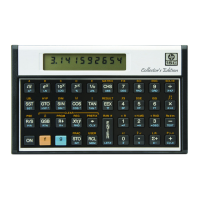Section 1: Getting Started 19
Notice that when you press the ´ or |
prefix key, an f or g annunciator appears and
remains in the display until a function key is
pressed to complete the sequence.
Prefix Keys
A prefix key is any key which must precede another key to complete the
key sequence for a function. Certain functions require two parts: a prefix
key and a digit or other key. For your reference, the prefix keys are:
" ^ • G f >
i O
m ´ | P I l F T
s ? t H b <
_
X
If you make a mistake while keying in a prefix for a function, press ´
CLEAR u to cancel the error. The CLEAR u
key is also
used to show the mantissa of a displayed number, so all 10 digits of the
number in the display will appear for a moment after the u
key is
pressed.
Changing Signs
Pressing ”
(change sign) will change the sign (positive or negative) of
any displayed number. To key in a negative number, press ” after its
digits have been keyed in.
Keying in Exponents
“
(enter exponent) is used when keying in a number with an exponent.
First key in the mantissa, then press “ and key in the exponent.
For a negative exponent press ” after keying in the exponent.
*
For
example, to key in Planck’s constant (6.6262 × 10
−34
Joule-seconds) and
multiply it by 50:
*
” may also be pressed after “ and before the exponent, with the same result
(unlike the mantissa, where digit entry must precede ”).
0.0 0 0 0
f

